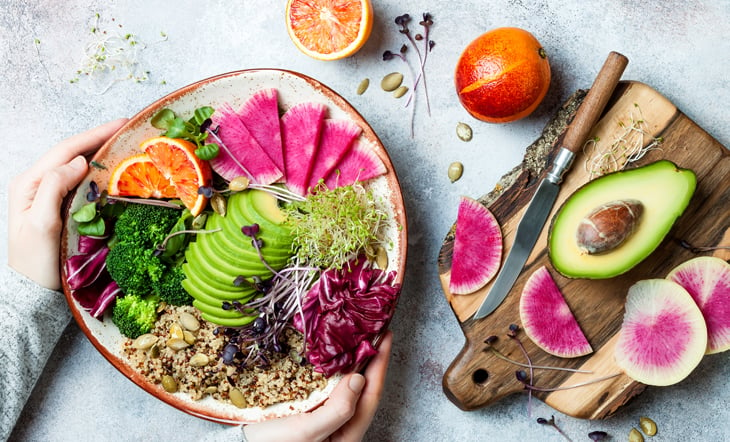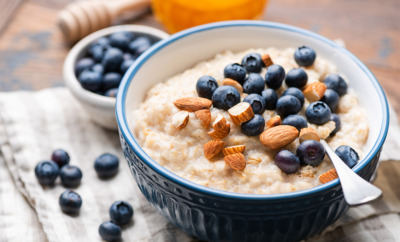Phytochemicals: A Guide to Eating the Rainbow With Plant-Based Nutrients

Plant-based diets and increased consumption of plant-based foods are credited with being very beneficial to human health. Studies have shown that higher intakes of plant foods are associated with reduced risk for many chronic and serious conditions.
But what is it about these foods that makes them so healthy for us?
Plants contain natural compounds known as phytochemicals or phytonutrients (the prefix Phyto means plant in Greek).
Read on to learn more!
First – What Are Phytochemicals?
Phytochemicals are compounds necessary for the plant’s survival, giving it a certain color and appearance and helping protect the plant from predators like insects and damage from excessive sunlight.
It turns out that the same chemicals that allow plants to grow and thrive provide several benefits for humans as well!
Consuming a variety of different plant-based foods is the best way to experience the health-promoting properties of phytonutrients.
There are thousands of phytochemicals found in plant-based foods including fruits, vegetables, legumes, soy, and even tea, coffee, chocolate, and wine.
Most plants contain multiple kinds of phytonutrients which give them different colors, textures, flavors, and abilities as natural pesticides.
Glyphosate In Your Food: What You Need to Know About This Chemical and Your Health
Phytochemicals 101: Your Colorful Guide to Plant-Based Nutrients
This guide lists the categories of the most common phytochemicals, what foods they are found in, and the major health benefits they offer.
Carotenoids
Carotenoids are pigments that provide bright colors to fruits and vegetables. They are fat-soluble which means they are best absorbed with sources of dietary fat.
A fun fact about carotenoids is that they are only minimally affected by changes in pH, which is why certain fruits and vegetables retain their color when mixed with highly acidic ingredients like vinegar or a highly basic solution such as baking soda.
Carotenoid is a phytochemical that has been associated with benefits to several body systems as well as overall immune health.
A well-known carotenoid is beta-carotene, found in yellow and orange-colored foods like carrots, squash, and sweet potatoes, converts to Vitamin A in the human body which is essential for vision, eye protection and skin health.
Another example is lycopene, a pigment that gives reddish color to fruits like tomatoes and watermelon as well as overtones to apricots, which has strong antioxidant capabilities.
Glucosinolates
Glucosinolates are primarily found in cruciferous vegetables including arugula, broccoli, cauliflower and kale and contribute to their strong aroma and flavor.
These phytochemicals are associated with reducing inflammation as well as improvement in metabolic and stress responses. They also have purported effects against carcinogens, which are cancer-causing compounds.
According to the National Cancer Institute, the broken down form of glucosinolates demonstrated inhibition of cancer development in several organs in animal studies.
6 Foods Science Says Can Help Prevent Cancer (Do You Eat These?)
Flavonoids
Flavonoids are a type of phytochemical categorized as polyphenols (this has to do with their chemical structure which contains at least one aromatic ring with one or more hydroxyl functional groups attached.
They are found widely in many different plants and exhibit antioxidant and anti-inflammatory properties. Flavonoids are also associated with anti-carcinogenic effects (similar to glucosinolates) as well as improved cognitive health.
A study conducted over more than two decades at Harvard University found that consumption of flavonoids was linked to reduced risk of cognitive decline.
Some examples of flavonoids include anthocyanins which are red, blue and purple colored pigments found in cherries, plums and acai berries, flavones which contribute to bitterness in parsley, celery, and tea, and isoflavones which are found primarily in soy products and fava beans.
Phenolic Acids
Another type of polyphenol, the most well-known phenolic acids are ellagic acid (found predominantly in raspberries, strawberries, walnuts, and pecans), gallic acid (found in blackberries, green tea, and vinegar), and ferulic acid which is found in cereal grains.
Like many other phytochemicals, ellagic acid has anti-carcinogenic properties like inhibition of cancer cells as well as preventing cell death known as apoptosis.
There are thousands of phytochemicals found in plant-based foods.
Gallic acid has been associated with anti-microbial, anti-inflammatory and anti-cancer functions.
Ferulic acid has demonstrated therapeutic effects against conditions including cardiovascular and neurogenerative diseases and is used in anti-aging skincare products due to its antioxidant capacity and abilities as a photoprotective agent similar to sunscreens.
Lignans
Found mainly in oilseeds like flaxseeds, sesame seeds and sunflower seeds, lignans are associated with reducing risk of hormone related cancers.
This is likely due to their similarity in structure to estradiol, which gives lignans the ability as a phytoestrogen to mimic estrogen’s hormonal functions in the body.
Additionally, dietary lignans are metabolized by bacteria in the colon and contribute to the overall health of the gastrointestinal (GI) tract.
Stilbenes
Stilbenes are another type of polyphenol associated with reducing oxidative damage and disease related to the aging process. The most well-known stilbene is resveratrol which is found in the skin of grapes and red wine.
4 Ways Drinking a Glass of Red Wine Contributes to Good Health
Resveratrol supports cardiovascular health and increased cerebral blood flow and has also been shown to suppress tumor growth in several research studies.
This Nutrition Coach Has 7 Pro-Tips to Help You Simplify Your Plant-Based Diet
Phytochemicals: The Takeaway
Phytochemicals provide essential functions for plant growth and survival while simultaneously offering a myriad of health benefits for humans.
Switching to a Plant Based Diet? Follow These 6 Tips (It’s Easier Than You Think!)
Consuming a variety of different plant-based foods is the best way to experience the health-promoting properties of these phytonutrients.
Be sure to never take a fruit or vegetable’s bright colors for granted, after all this is the work of some amazing compounds!
All included information is not intended to treat or diagnose. The views expressed are those of the author and should be attributed solely to the author. For medical questions, please consult your healthcare provider.


This Month's Letter
From the Editor
Monthly motivation and food for
thought from our founder.






























Comments